Belugas, Bears & Birds Trip Report 2025
This was a super group and we had a great time. At our final meal together we shared some of our favorite birds, mammals & other highlights from the trip. Some of the highlight mammals that were mentioned were of course the Polar Bear & those cute, curious Belugas that definitely topped the list. Others mentioned included the first Badger that we got such great looks at as it ambled down the road, a Pine Martin that stood in the ditch before crossing the road right in front of us, 70 or so Bison that we admired from an elevated lookout, the Black Bears, Arctic Hares, 13-lined Ground Squirrels, the close up Beaver, and even the chipmunks and muskrats were mentioned as highlights.
There were many birds mentioned as well including the colorful Indigo Buntings, Scarlet Tanager, and Mountain Bluebird male. We saw numerous females with broods but the most memorable ones may have been the Sharp-tailed young that seemed to be practicing their lek dancing skills, the striped baby Pied-billed, Red-necked & Eared grebes including some riding on their parent’s backs, the tiny red-feathered American Coots, the Pacific Loon with a chick, Tundra Swans with young, and so many broods of ducklings for nearly every species we encountered. We ended up with an amazing 220 birds and 30 mammal species for the trip; I think everyone had several lifers. Hopefully this report will serve to relive some of those great memories.
Day 1 – July 11
We met in the lobby of the Hampton hotel that first evening, talked a bit about what to expect the next few days, and walked over to Chicago Joe’s where we dined, got acquainted and discussed more trip logistics. Some of the participants had arrived early and had gone to Assiniboine Park today – we added some of the birds and mammals they saw there for Day 1 on our list including single Cooper’s Hawk, Chimney Swift, Ruby-throated Hummingbird, Eastern Wood-Pewee, Eastern Cottontail, and Leopard Frog and multiple Wood Ducks, Great Crested Flycatchers, White-breasted Nuthatches, Muskrats, and Eastern Gray Squirrels. The couple from Scotland really enjoyed watching Red Squirrels chasing the Grays as it’s the other way in their country. But, tomorrow would be a full day with a fair amount of driving and several stops along the way, so we packed it in early that evening.
Day 2 – July 12
Stocked with coffee and tea from the lobby, and bag breakfasts from the hotel, we left the hotel shortly after 5:30 bound for St Ambroise on Lake Manitoba. On the way, we spotted the first of 4 Red-headed Woodpeckers for the day, as well as our first Upland Sandpiper, Northern Harriers, American Kestrels, Red-tailed Hawks and Western Meadowlarks. Near St Ambroise we stopped to look at some Gray Catbirds, Brown Thrashers, Cedar Waxwings, American Goldfinches, Brewer’s Blackbirds, Clay-colored Sparrows, Bobolinks, Orchard & Baltimore Orioles, 2 Black-billed Cuckoos, Purple Martens, plus some fly-over Marbled Godwits, Black Terns, and Black-crowned Night Herons. In the marsh we’d get first looks at Common Yellowthroats, Swamp Sparrows, March Wrens, and a Sedge Wren that did the splits straddling two reeds at once. At St Ambroise beach we’d have breakfast, and add a few birds (House Wren, American White Pelicans, Double-crested Cormorants, Forster’s Terns), plus a couple Groundhogs, Franklin’s Ground Squirrels, and American Toads. At our next stop, the PR227 garbage disposal site, we’d look over hundreds of Ring-billed, Franklin’s & Herring Gulls and eventually spot an adult California Gull, an immature Lesser Black-backed Gull, and a sub-adult Iceland Gull. A couple Bald Eagles (11 for the day!), and some Turkey Vultures also were added there.
Our next stop, Cal’s place along the Portage Creek, produced a Wood Duck, Belted Kingfisher and Lesser Yellowlegs in the pond, Ruby-throated Hummingbird at the feeder, and some shy Great Crested Flycatchers, an Eastern Phoebe, and Least Flycatchers. Making time, we drove straight to Neepawa where we had lunch. Taking country roads south of the park, the Rolling River road into Riding Mountain National Park, and PR19 to our resort, we added a few birds including a couple Broad-winged Hawks, a roadside Ruffed Grouse, a Common Goldeneye with young and Ring-necked Ducks, plus a few mammals (Richardson’s Ground Squirrels, Snowshoe Hare, and the first of 3 Black Bears for the day). Getting to the Elkhorn Resort, we’d have a couple hours to unpack and relax before heading to the Golf Club House where we enjoyed a lovely dinner. The evening’s agenda was an optional trip to the Bison compound. On the way we’d get our first Bank Swallows, hear an American Bittern, and see some family groups of Red-necked Grebes. A stop at Lake Audy gave us our first Common Loons and close-up looks at a swimming Beaver. Entering the bison compound, a truck stopped to tell us they’d seen the bison near the observation mound. Sure enough the entire herd (some 70 animals including a dozen calves) were situated very close below the observation mound. Leaving the lookout we got onto a Swainson’s Thrush, and on the drive back had the afore mentioned close encounter with a Pine Martin.
Day 3 – July 13
At Riding Mountain National Park, we’d settle into a routine getting out by 6 am, do some birding or drive around for an hour or so, stop at a bird-rich picnic spot for a picnic breakfast, and bird some more through the morning before stopping at another nice picnic spot for lunch. In the afternoon, we’d bird for a 2-3 hours before heading back for a couple hours rest, have an early dinner, and do an optional evening of birding or looking for mammals for 2-3 hours. Today, pre-breakfast, we cruised north on Highway 10 and back hoping to spot a Moose but settling for brief looks at an Evening Grosbeak, two Canada Jays, and more Black Bears (one a nice brown color-phase adult). Breakfast was at Grayling Lake, where we’d add several birds (Common Loons, Ovenbird, Yellow-rumped & Chestnut-sided Warblers, American Redstart, Purple Finch, and a calling Blue Jay). Driving south, someone spotted a Northern Hawk-Owl but most of us just got fleeting looks at it. A Pileated Woodpecker flew over but many had to settle for a heard-only on it, and we spotted a couple more Broad-winged Hawks. At a favorite stop near the Lake Audy turnoff, we added Ruby & Golden-crowned Kinglets, and some Boreal Chickadees.
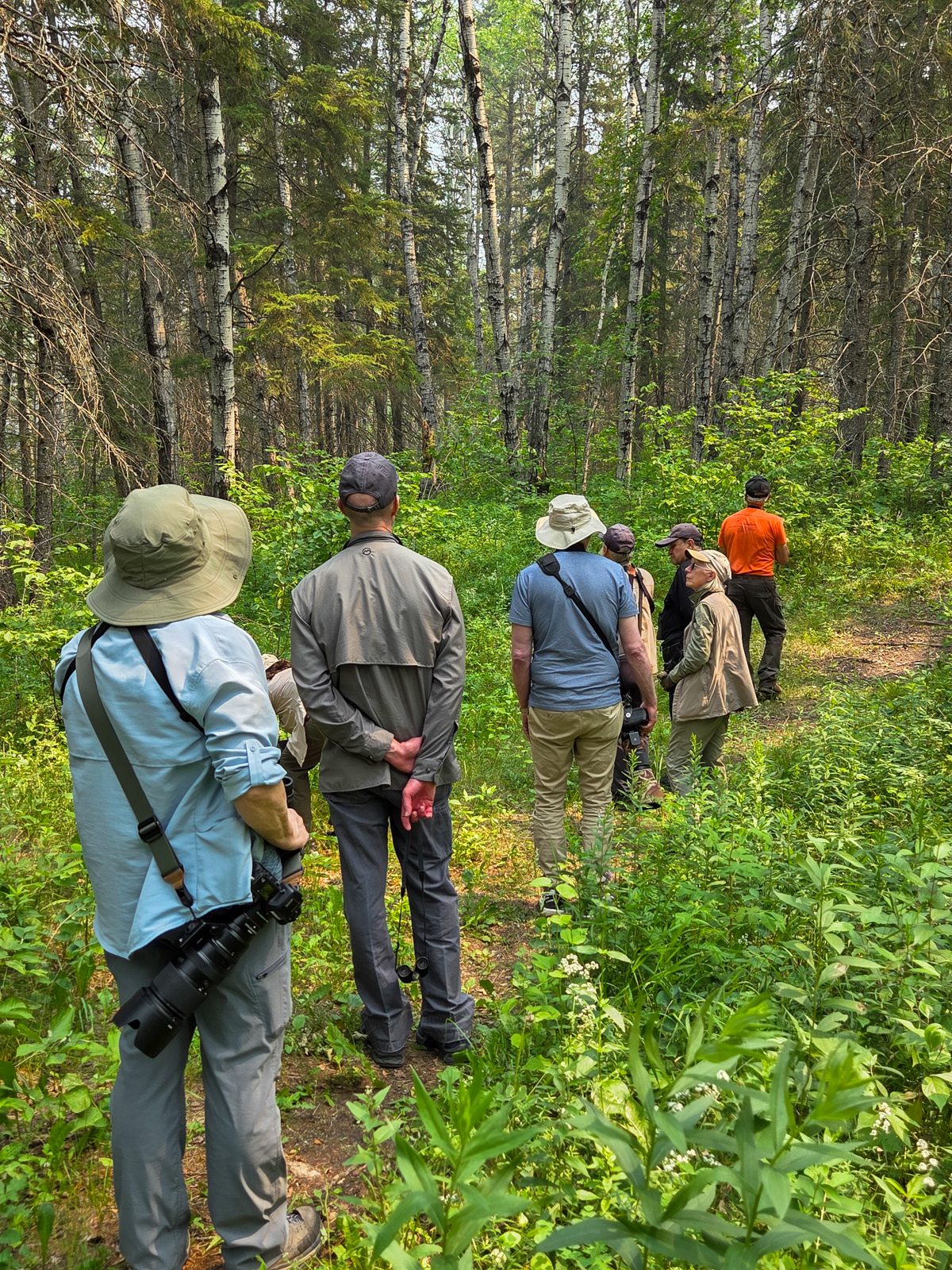
© Joanna Fraser
Turning off Hwy 10 onto the North Shore loop, we walked several stretches adding Magnolia & Nashville Warblers, White-breasted Nuthatch, more Boreal Chickadees and a few Yellow-bellied Sapsuckers. We had lunch at Lake Catherine and walked a trail along the lake afterwards good for a couple Meadow Voles, a Least Chipmunk, and some mystery birds (that turned out to be juvenile Eastern Phoebes). After a couple hours off, we had an early dinner at TR McCoy’s in Wasagaming. After dinner, a few of us still hoping for a Moose, drove north on Hwy 10 stopping at Moon Lake, Crawford Creek, the Beaches parking (Philadelphia Vireo), and the park’s north boundary road (Veery). On the way back we tried calling in a Northern Hawk Owl near the spot where it had been seen earlier, and at our next stop several scolding Robins not too far of the road told us that they were likely harassing a perched owl. It flew a bit deeper into the woods followed by more robin commotion but we never were able to get a look at what had them so excited.
Day 4 – July 14
This morning we started out by walking a stretch of road near the Wishing Well (good for a Mourning Warbler and more Chestnut-sided Warblers), before heading to our breakfast spot at Whirlpool Lake picking up a couple Coyotes, Snowshoe Hares, and the only Blue-headed Vireo and Hairy Woodpecker (both heard only) that we encountered for the entire tour. During and after breakfast we’d get brief looks at some Evening Grosbeaks, a couple of far-off Trumpeter Swans on the lake, several warblers (Yellow-rumped, Cape May, Black-and-white, Tennessee), a Brown Creeper, and a Least Chipmunk on a stump where several large Plains Garter Snakes were later found. On the way to the east escarpment, we’d see more Black Bears (first of 4 today), some Ring-necked Duck and Bufflehead broods as well as a family of Wild Turkeys. We took some photos of the historic East Gate before driving around to the Agassiz Ski Hill Road west of McCreary. Here in short order we’d get great looks at Indigo Bunting (5 today), a splendid Scarlet Tanager, and a couple Hermit Thrushes.
After a picnic lunch at the base of the former Agassiz ski hill, we called in an Eastern Towhee and carried on back to PR19 stopping at the east gate (Lark Sparrow), Whirlpool Lake (still hoping to call up a Black-backed or Three-toed Woodpecker), and the S-curves on PR19 (where Ken walked a stretch of woods hoping to find a Spruce Grouse). Once again, we’d have a couple hours off in the afternoon, an early dinner at TR McCoys and a few of us went out in the evening. Today we’d head south of the park checking out several smaller ponds (first Blue-winged & Green-winged Teal, Northern Shoveler and Pied-billed Grebes) and a large lake loaded with at least 50 Red-necked Grebes, 40 pelicans, 300 cormorants, various other waterbirds including our first Great Blue Herons, Lesser Scaup, Redheads, Canvasbacks, Ruddy Ducks, several Eared Grebes, Hooded Merganser, Horned Grebe and some Eared & Western Grebes. Driving gravel roads, we were unsuccessful in locating any Great Gray Owls in areas where they had been seen in previous years but we did scare up our first Gray Partridge, 2 Merlins, and get a glimpse of a Short-tailed Weasel as it darted across the road.
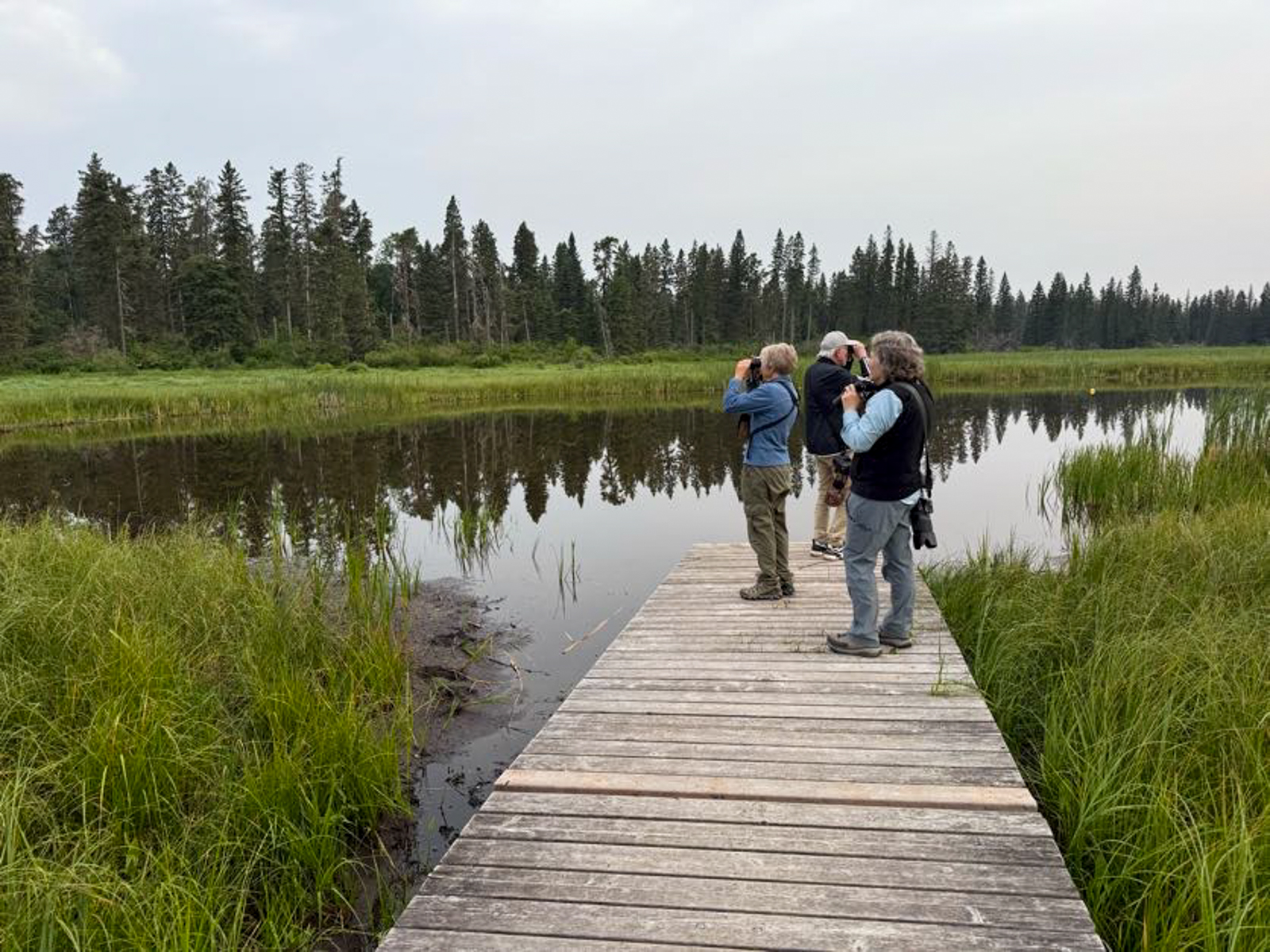
© Laurie Stelljes
Day 5 – July 15
Today we had a fair bit of driving with multiple stops along the way, so we loaded up and were off at 6. On the way to our breakfast spot, we stopped at Proven Lake hoping to encounter a Great Gray (as two had shown up here last year) and we made several stops listening for LeConte’s or Nelson’s Sparrow. On the way to Minnedosa, a Sharp-shinned Hawk darted across the road. In Minnedosa, we stopped at a small park along the South Saskatchewan River taking advantage of a break in the sporadic drizzle that morning to have a rather quick picnic breakfast. Carrying on to pothole country, a series of small glacial depression lakes south of town, we’d get better looks at most of the waterfowl and other waterbird species including a nice variety of females with broods (Canada Goose, Wood Duck, Shoveler, American Wigeon, Mallard, Ring-necked Duck, Bufflehead, American Coot, Red-necked & Pied-billed Grebes). We also found our first and only Semipalmated Plovers and Yellow-headed Blackbirds, a Least Sandpiper, a handful of Lesser & Greater Yellowlegs, an American Bittern, an estimated 40 Black Terns, and 10 more Bobolinks. We carried on to Brandon picking up some Upland Sandpipers, plus our first Western Kingbirds and Swainson’s Hawks. Later, we stopped at a pond where a couple Virginia Rails responded to playback and came right up to the road but we were never able to get a look at them.
We had lunch in Boissevain, and checked out some of the town finding some Eurasian Collared-Doves and a Fox Squirrel. Next, we backtracked to a lake near Ninga where we had 35 American Avocets, a Horned Grebe and a few Eared Grebes, plus a really good number of shorebirds (at least 200 Stilt, 50 Semipalmated, 15 White-rumped & 2 Baird’s Sandpipers), plus 75 Short-billed Dowitchers and 20 more Lesser Yellowlegs. We headed west of Boissevain around the north and west sides of Whitewater Lake, adding a Marbled Godwit, more Horned Larks and Vesper Sparrows, and a surprising 125 migrant Red-necked Phalaropes on one small lake. Near the west end we spotted a Badger hunting along a roadside and had phenomenal looks as it approached with its tail held high until it noticed us and dashed off into the ditch. From there, we highwayed it to Melita and had more than an hour’s rest before heading uptown to a restaurant. After dinner we cruised the downtown section hoping to find Chimney Swifts and eventually found two circling low over town plus a few more Eurasian Collared-Doves.
It had been a long day but a few folks ventured south of town that evening for 3 hours. It turned out to be a particularly productive evening finding our first Ring-necked Pheasant and Northern Pintail, more Gray Partridges and Merlins, 36 more Upland Sandpipers, another Lark Sparrow, 2 Coyotes, a Raccoon and the first of 13 White-tailed Jack Rabbits we would see in the next three days. In some good prairie near Coulter we added a Ferruginous Hawk in a large man-made nest (a nest constructed of a wire basket with some sticks added which Ken had erected about 40 years prior). In some expansive pasturelands in the “Blind Souris” (a valley which was once carved out by the Souris River) we heard a couple Grasshopper Sparrows and 3 Baird’s Sparrows.
Day 6 – July 16
This year, a whole day had been added to the tour to adequately accommodate all the unique wildlife that the southwest corner of the province has to offer. After a 6:30 continental breakfast at the hotel we headed to the extreme southwest corner, on the way adding a couple Ring-necked Pheasants, the afore-mentioned Sharp-tail with 3 dancing chicks, more Gray Partridges (6 for the day), White-tailed Jack Rabbits (8 today) and a couple Loggerhead Shrikes. But our main targets were four grassland birds that are endangered nationally; all are scarce and located only in selected native habitat in this corner of Manitoba. Pulling up to a crown-owned prairie west of Lyleton, we crossed a fence and walked single file (to avoid stepping on nests) to where a Baird’s Sparrow was calling (one of 7 Baird’s that were heard in this and other native habitat nearby). We eventually were able to get superb looks at it, and switched onto a couple Grasshopper Sparrows calling nearby getting excellent scope looks at them. Sprague’s Pipits had been heard sporadically while searching for the sparrows, but they had stopped and we had to wait for a while before one was heard displaying high overhead. Using playback, we encouraged it down to the ground (coming down from above in a steep plummet). It landed a short distance from us and we were eventually able to get some decent looks as it walked through the thin grass. Chestnut-collared Longspurs were the last of the big four, and we’d heard one along the grassy trail on our way in, so we stopped on the way out and had great looks at a male that landed on the fence nearby.
Elated at our success in the prairies, we headed for a rest stop in Pierson, crossing and stopping at a couple bridges where an estimated 300 Cliff Swallows spilled out from underneath. Ambling south and east to the border with Saskatchewan and within a mile of North Dakota, we’d get close up looks at a young Mule Deer buck and catch a fleeting look at another Badger. We stopped for lunch at Coulter Park, a quaint little park at the confluence of Antler Creek and the Souris River. There, we would spot a number of 13-lined Ground Squirrels, and locate a pair of Say’s Phoebes. Heading south we counted at least 35 Bank Swallows and a couple Northern Rough-winged Swallows popping in and out of nesting holes in the banks of the Souris River. Nearby, in a chunk of riparian forest, we heard and eventually got good looks at a couple Yellow-throated Vireos. Pulling up to an oxbow of the Souris River, a couple Western Painted Turtles were spotted sunning themselves on logs along the water’s edge.
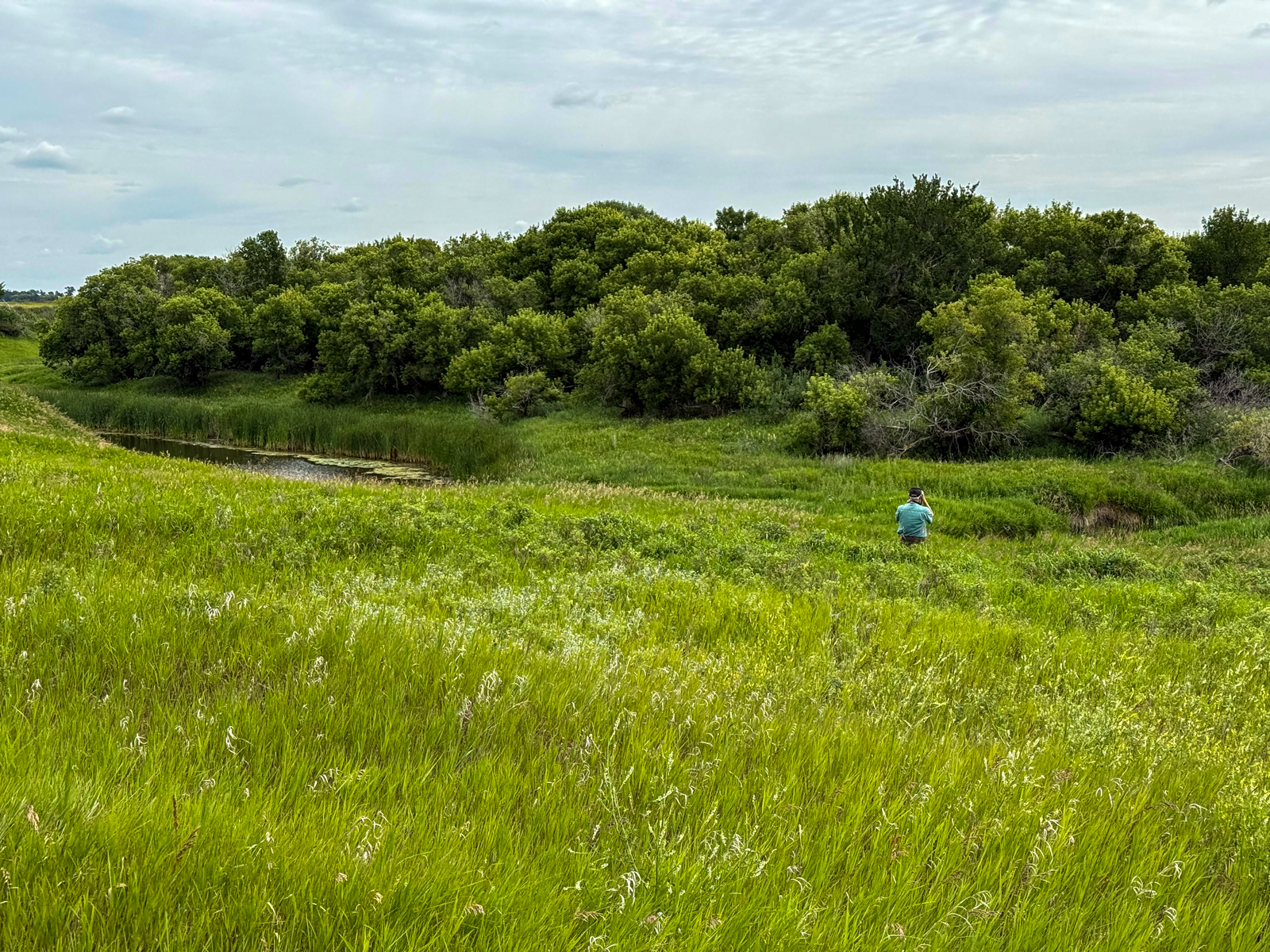
© Laurie Stelljes
Next on the agenda was a trip through a stretch of sparsely populated grasslands known as the Poverty Plains stretching some 25 miles from Pierson to Broomhill. We hadn’t gone far when a Ferruginous Hawk was spotted in flight and then perched on a roadside utility pole. Another adult was found perched in a nearby tree where the pair had been observed on a nest earlier this year (the somewhat flimsy nest had apparently fallen!). Below the tree, one fully grown young was obvious. We carried on through the Poverty Plains spotting more Loggerhead Shrikes (7 for the day), Swainson’s Hawks (9 today) and Upland Sandpipers (40 today). Mourning Doves (at least 350), Eastern Kingbirds (300+), Brown-headed Cowbirds (200), Brewer’s Blackbirds (500), and to a lesser extent Western Kingbirds (50) were also extremely abundant today. At one stop, a soaring Cooper’s Hawk was observed but it was too distant and disappeared before most could get onto it. At a spot where Burrowing Owls had been released until a couple of years ago, we spotted a distant adult on a post with at least one young on the ground below it. Much further out, another adult was spotted on a short post — presumably a second pair! Since the Burrowing Owl is nearly extirpated in Manitoba (some years there are no known nesting pairs), the possibility of two nesting pairs here was very surprising. Heading back to Melita, we had superb looks at a Black-billed Cuckoo on a fence near a stretch of tall roadside cottonwoods. A Rose-breasted Grosbeak was heard and briefly spotted in those same cottonwoods, and 4 Brown Thrashers were observed here and elsewhere that day.
We got back to Melita with an hour to relax before dinner. That evening some of us headed to the Lauder Sandhills, but not before hunting up a few House Finches in town, and a Willow Flycatcher, another Mule Deer, a Say’s Phoebe, and 3 more White-tailed Jack Rabbits on the way. In the Lauder Sandhills, White-tailed Deer were everywhere (a total of 101 were tabbed that evening!). But our main target for the evening was Common Nighthawk and at a stop near Grand Clairiere we located a displaying/hunting pair.
Day 7 –July 17
Today would be our biggest travel day yet, as we needed to make our way from the extreme southwest to Winnipeg. We wanted to take one more look in the southwest for Moose (as there is actually a better chance of seeing one in agricultural lands with scattered willow clumps here than in their typical wooded habitat of Riding Mountain)! Heading west and north to Tilston, we would luck into a couple quite large Great Horned Owl young in an abandoned yard. In a pond near Tilston, a Solitary Sandpiper was spotted – the only we would locate on this tour. We’d also spot a couple threesomes of flying Ibises in the middle of nowhere while driving gravel roads to Pipestone! Near Bellview we accessed a portion of the extensive Oak/Plum Marsh where we would get better looks at a couple Black-crowned Night Herons, more White-faced Ibises, a couple Sedge Wrens perched on trailside fence posts, and some Nelson’s Sparrows that called nearby but would cooperate not provide us a look.
Next we made our way to the Oak Lake resort, spotting an Eastern Wood-Pewee when we stopped for a restroom break. Checking out the dike separating the lake from the marsh, we encountered more Eared & Western Grebes, and some close up American White Pelicans and cormorants. Just outside the resort we stopped at a pond with some shorebirds and came up with the only Willet we would find on this trip. We were ahead of schedule so we carried on to Brandon where we’d have a sit-down lunch at a Subway. Next, we headed east to Shilo where we would find a mixed pair of bluebirds feeding young (a male Eastern and a female Mountain), and down the road we got onto a splendid sky-blue male Mountain Bluebird.
It was now time to make tracks to Winnipeg, so we hit #1 Highway and made it to the Hampton by 4. We had more than a couple hours to kill before dinner, so a few of us went downtown and found 2 Peregrine Falcons perched on buildings near their downtown nest site. Carrying on to Kildonan Park, we could not locate the Red-bellied Woodpeckers that nest there, but a male Indigo Bunting and a number of Wood Ducks with young were some consolation. Dinner that evening was at Chicago Joes. Afterwards folks got ready for the next phase of our tour (Churchill), while Ken dropped off some gear he didn’t need in the north at his home and returned the rented van.
Day 8 – July 18
Our flight to Churchill today was at 10:30, so we were able to get up at a leisurely time, have the continental breakfast at the hotel, and take the shuttle to the airport around 8. The flight was just slightly delayed, and we arrived in Churchill at 1:15. But, by the time we’d made our way to the Polar Inn, unpacked, and had lunch in the hotel’s dining area, it was 2:30. With the late start, we hit the ground running checking out the Granary Ponds (our first Greater Scaup, Arctic Terns and many Herring Gull young), the Lower Docks (Common Eider with young and our first look at Belugas in the Churchill River), Cape Churchill (many more Belugas, some flying White-winged Scoters and Bonaparte’s Gulls, a couple Red-breasted Mergansers, and the first of 15 Whimbrels for the day) and the Beach (more White-winged Scoters, Red-breasted Mergansers and a Ringed Seal).
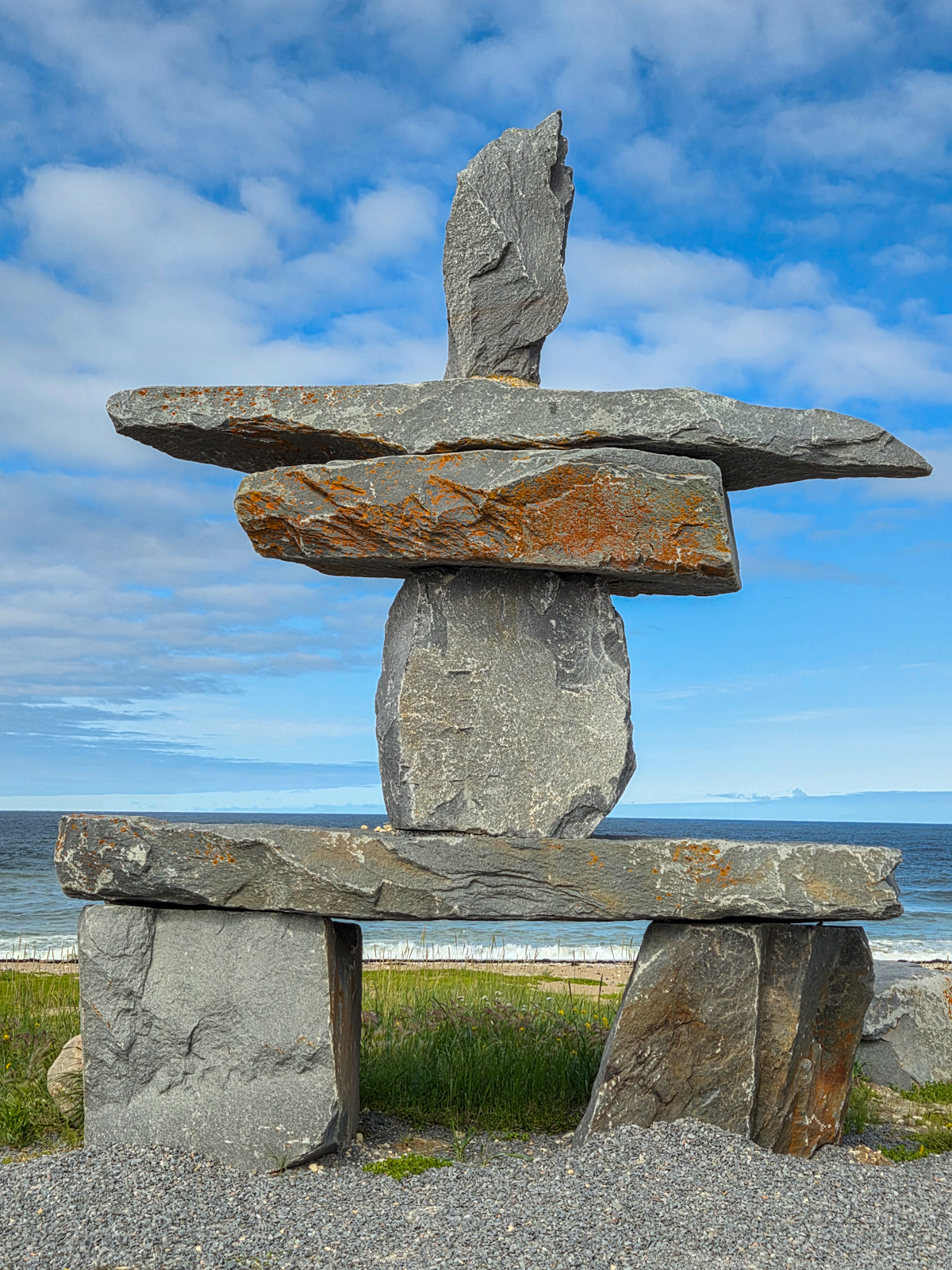
Inukshuk in Churchill © Joanna Fraser
Heading out of town on Launch Road to Akudlik there’d be many Canada Geese with young and a few Tree Swallows near nest boxes. At Akudlik a feeder would have the first of 20 White-crowned Sparrows today, we heard a Lincolns Sparrow, and got brief looks at a couple Redpolls. In flooded ditches along Goose Creek Road there would be some American Wigeon, Pintail and Green-winged Teal broods, and a few Lesser Yellowlegs, 2 Greater Yellowlegs, 5 Stilt Sandpipers and a single Short-billed Dowitcher. Approaching the feeders at the Goose Creek Cabins, we would encounter a small group of warblers which included a couple Yellow-rumped, and at least one Blackpoll and a Palm Warbler. The feeders are always worth checking and we were excited to find Redpolls, Pine Siskins, Dark-eyed Juncos, Fox & White-crowned Sparrows, and 5 Pine Grosbeaks. Near the Marina were 15 Rusty Blackbirds, some Northern Waterthrushes and an Alder Flycatcher. Flooded ditches and semi-open scrub along Hydro Road would offer some large Hooded Merganser young, a Common Goldeneye, a couple Northern Harriers, and the first of 5 Bald eagles for the day. Looking over the river at the end of Hydro Road (CR30), we counted at least 30 Tundra Swans near the opposite shore.
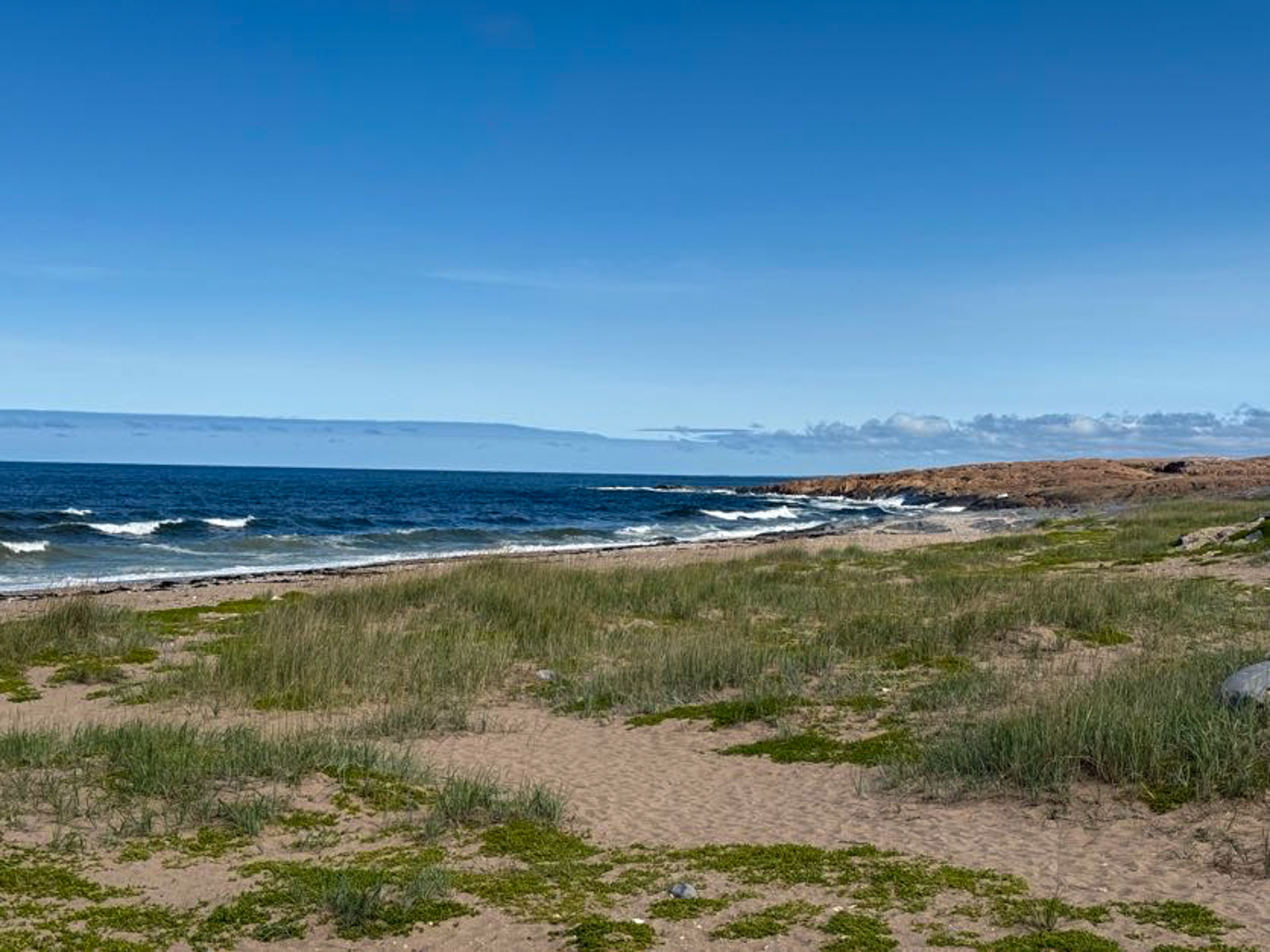
Churchill landscape © Laurie Stelljes
On the way back we spotted 2 Sandhill Cranes, an Osprey near the Marina, and a couple Greater Scaup females with 20 chicks at the Weir. But it was time head back as we had dinner reservations at the Ptarmigan restaurant at 7. After dinner, most of the group wanted to give the Willow Ptarmigan and Spruce Grouse a decent chance, so we raced down Launch Road past the Northern Studies Centre picking up a couple Pacific Loons, an American Kestrel and a Merlin. On the rather rough and potholed Twin Lakes Road we drove slowly scouring the roadside edges and nearby semi-open areas all the way past the shorebird fen to and including Cook Street but we would not find any. On the way back we were treated to a gorgeous sunset.
Day 9 – July 19
Our routine in Churchill was an optional pre-breakfast excursion to some sites near town for an hour, coming back to a nice continental breakfast at the Polar Inn at 7 or shortly after. Today a Northern House Wren greeted us as we stepped out of the hotel (a rare bird for the north). In the Flats were many Whimbrels (35 today) a few Hudsonian Godwits, huge numbers of Canada Geese (most of the days very conservative 800 Canada’s), and a couple Bald Eagles (8 today). We also had our first Arctic Hare here, but 3 more were spotted in town before breakfast! There was nothing new at the Beach, but a feeder in town yielded close-up looks at a Harris’ Sparrow.
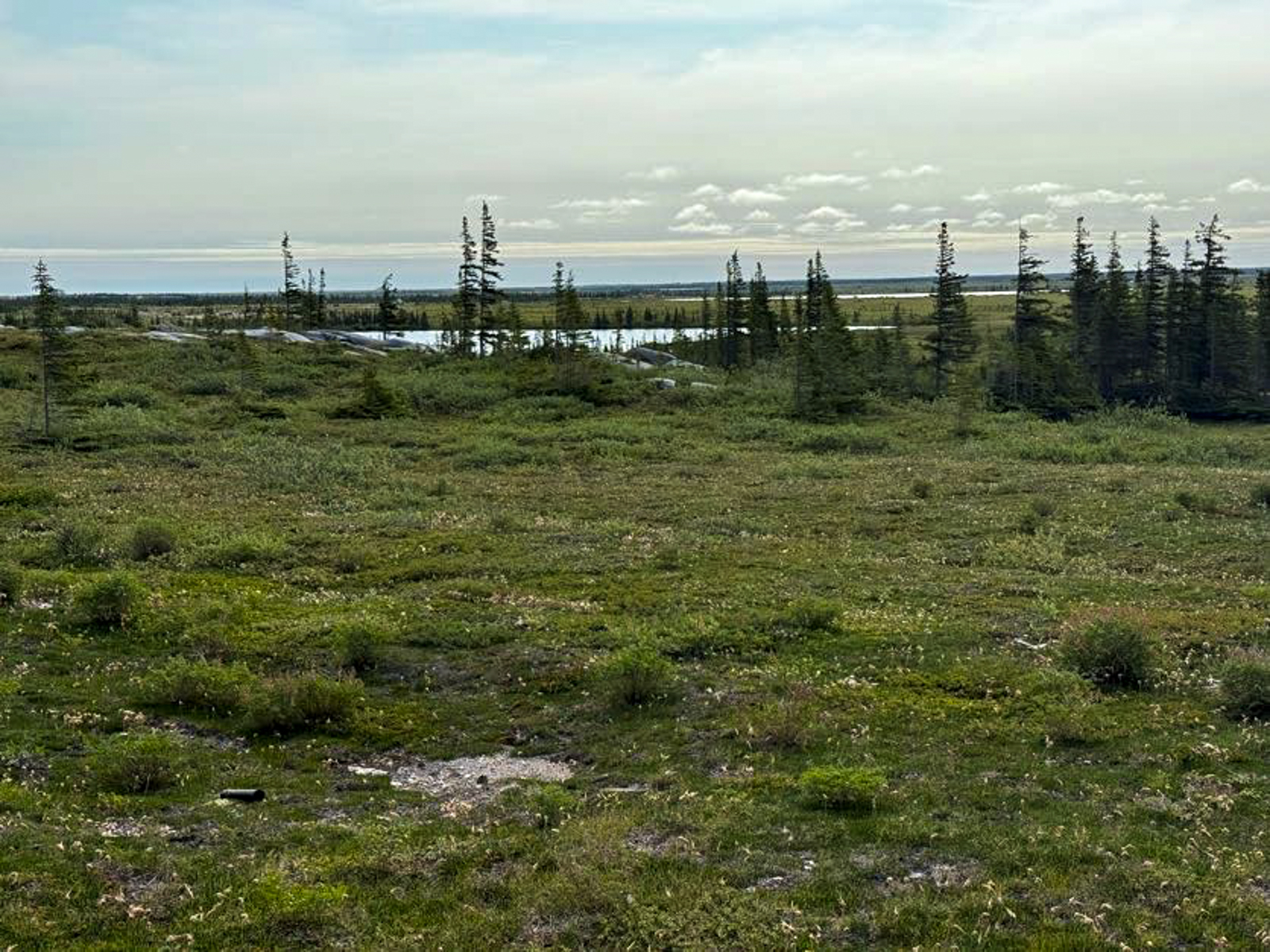
© Laurie Stelljes
After breakfast, we checked Cape Merry where we had our first Parasitic Jaeger and Black Scoters (10), as well as more Red-breasted and White-winged Scoters. We headed out of town along Launch Road getting close-up looks at Pacific Loon and Parasitic Jaeger, and our first American Golden Plovers (6 today). We checked out Polar Bear Alley where a caribou had been seen the day before, getting good looks at a Lincoln’s Sparrow but little else. Halfway Road can be sometimes be good for mammals and we were excited to see two Tundra buggies at the end of the road, the passengers looking intently and pointing to the left. They indicated that a Polar Bear had been seen far out towards the studies centre but really all we could see were some distant white rocks. The buggies soon left, never even stopping as they got closer to where it had been seen, so we really wondered about their sighting. Nevertheless, after adding a fly-by Golden Eagle we took many closer looks for the bear including driving down Fox Drive near where it had been reported but we saw nothing.
It was time to head back to motel for lunch and to get ready for the beluga zodiac tour. On the way back, however, we saw a couple vehicles parked alongside some rocks past Polar Bear Alley. Stopping a ways back, there it was — a dozing Polar Bear among the rocks! We excitedly took scope looks and then approached to where the vehicles had been. From there we could now see the bear quite close and took pics and had great looks at it as it lazed on the rocks occasionally lifting its head to look around. We were definitely excited and half expected to see more bears when we went closer to Eskimo Point later with the Zodiac but none were found there.
The water in the bay and the river was pretty choppy today but we did get pretty decent pics and looks at hundreds of Belugas during the two hours we were on the Zodiac. A bonus was a rare dark-phased Parasitic Jaeger that harassed a gull close to the Zodiac. After, we had more than an hour to do some birding before 5 o’clock reservations at the Polar Inn’s dining restaurant, so we took another drive down Goose Creek Road and part of Hydro Road adding a couple a couple Orange-crowned Warblers (heard), more Sandhill Cranes (10 today) and our first Red-necked Phalarope and Sora (heard) for the north.
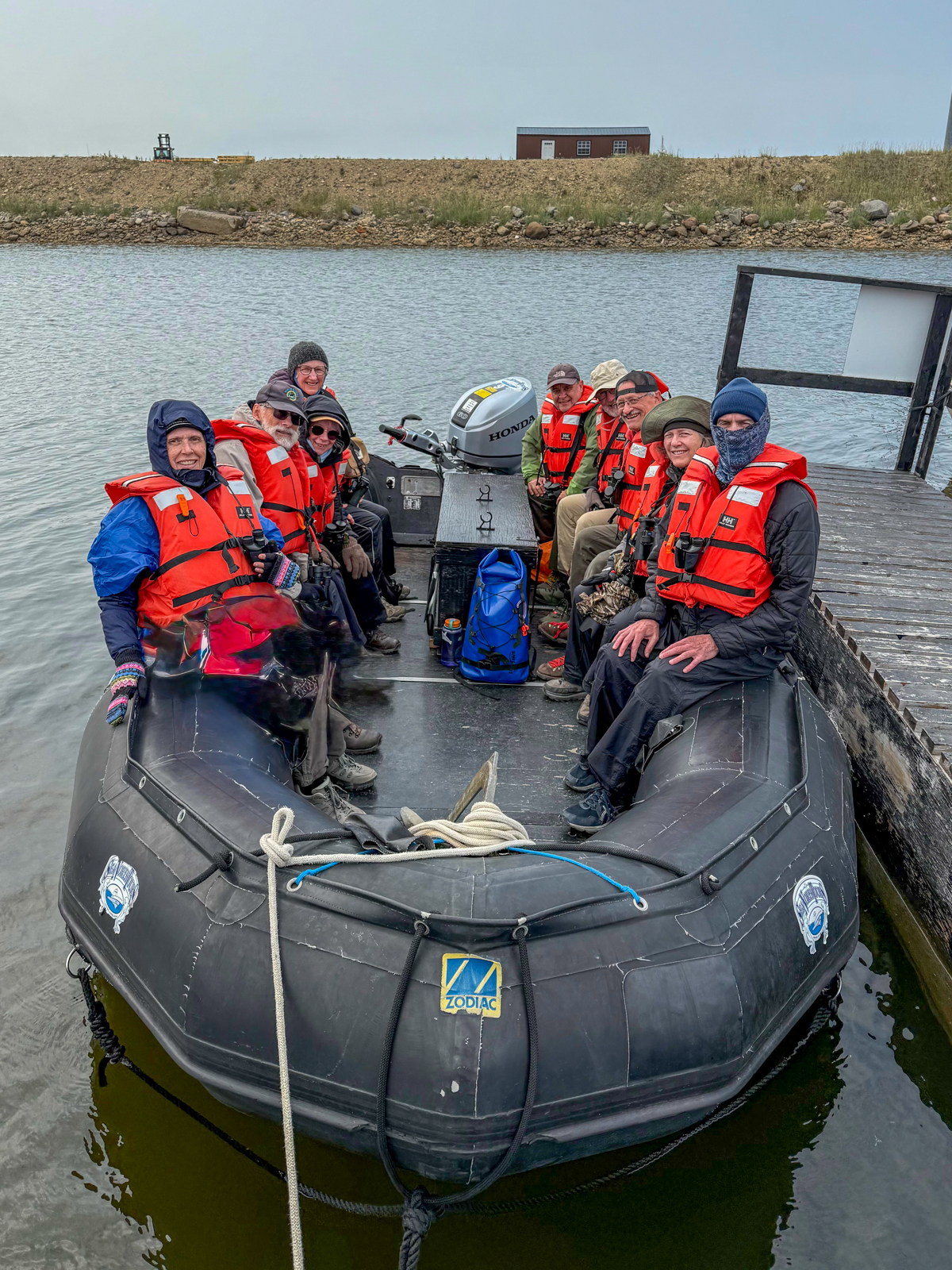
Our group heading out to look for belugas © Laurie Stelljes
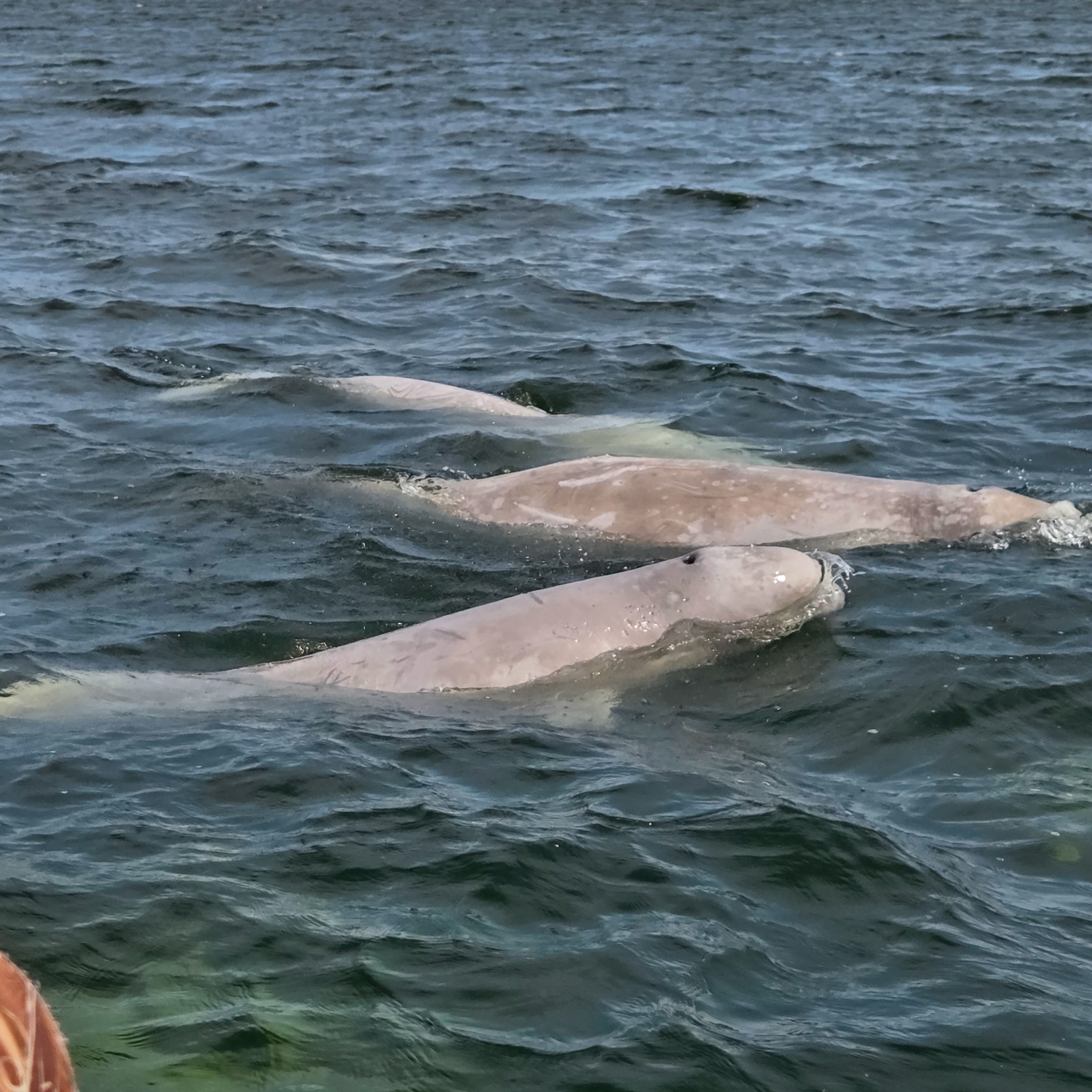
Belugas © Joanna Fraser
That evening we had more time to look for the ptarmigan and grouse so we headed back to Twin Lakes Road driving slowly to beyond where we had gone yesterday and even walking a stretch where the grouse often frequented (bad mosquitos!). We checked Ramsey Drive by the studies center but once again we could not find our target birds settling for a family of Tundra Swans, our first Canada Jays and American Crow for the north, and a Deer Mouse that scampered across the road.
Day 10 – July 20
The pre-breakfast jaunt had been so successful yesterday that most of us headed out at 5:30 today. We checked out town (4 more Arctic Hares), the railway tracks at the flats, and headed out Goose Creek giving the Nodwell trail a look getting our first decent looks at Orange-crowned Warbler and adding our first Boreal Chickadee and Cedar Waxwings for the north. After Breakfast we hit the Flats (a lot more Hudsonian Godwits (35) and about 20 Whimbrels), and had an extended look at Cape Merry adding our first Surf Scoters to the usual complement of both Scoters, jaegers and other waterbirds there. But the best birds were a pair of Black Guillemots (a rare bird for the north) that were seen by only one observer but who was very familiar with the species and saw its field marks well (the oval wing patches and red legs). They landed in the river before the rest of us could get onto them, dove, and could not be relocated.
Next we drove down the Coast Road (more Close Pacific Loons and Miss Piggy), checked some Launch Road offroads including the Rifle Range (Tundra Swan pair with 4 chicks), Bird Cove Road (nice outlook quite close to the Ithica ship stranded since the 1960s) and Scrape Metal Road that connects up with Goose Creek Road. As we approached the Goose Creek feeders a flock of White-winged Crossbills lit in some spruce trees (great looks), the feeders had the usual complement of birds, and at the Marina we had our first looks at American Tree Sparrow. We headed a short distance up Hydro Road hoping to find a Little Gull (the only location where they have been seen this summer) but settled for our first Sanderlings and American Black Ducks.
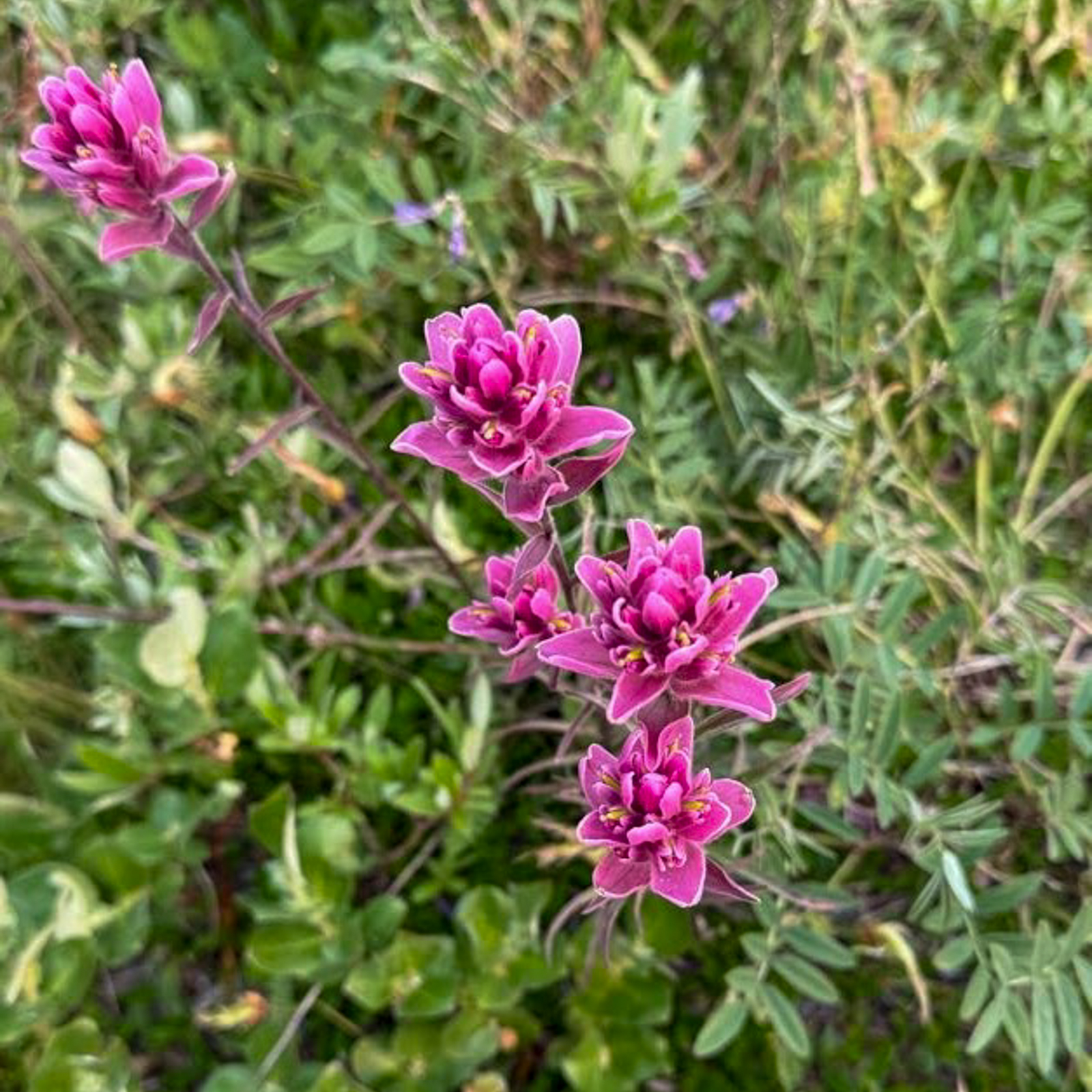
Wildflowers © Laurie Stelljes
It was time to head back for lunch and today’s 2 o’clock Zodiac ride to the Prince of Wales fort and for Belugas. Once again the Polar Bears that had recently been seen in the rocks at Eskimo Point were not obvious today, but we had incredible looks at the Belugas today especially the larger white adults. It was 4:30 by the time we left the water, so we took some time off, had an earlier dinner at the Ptarmigan (our favorite eating place) and once more a few of us went searching for the elusive ptarmigan and Spruce Grouse. We did a more thorough check at Kennedy Park for the grouse and drove slowly in areas where ptarmigan are regular in spring near the studies center, along stretches of Twin Lakes road, and at the shorebird fens. We did have another flock of White-winged Crossbills, a Pacific Loon with a chick, but still no luck with the ptarmigan or Spruce Grouse. We took in another beautiful sunset and called it a night.
Day 11 – July 21
Today would be our last day of the tour and our last day in Churchill! A few of us headed out before breakfast taking better looks at the granary ponds (2 Red-necked Phalaropes & 2 Least Sandpipers), another extended look at Cape Merry (nice but nothing new), and at the feeders in town (another look at the Harris’ Sparrow). After breakfast we drove a road into the far end of the flats (Snowshoe Hare plus 6 of the 10 Bald Eagles seen today) and had a look at the ponds and feeder at Akulik. We took one last look at Kennedy Park — this time scaring up a couple Spruce Grouse but they flew off giving us only flying looks. The feeders, Hydro Road, the Marina and the Weir offered us little new, save for our first Bufflehead for the north, plus 8 more Sandhill Cranes and 20 Stilt Sandpipers, so we headed back to check out, load the van and have lunch. Afterwards, half the group explored some of the shops in town as well as the museum and parks Discovery Centre. The rest of us checked out the Beach (this time spotting a Harbor Seal) and one last visit to Cape Merry (Belugas cresting wherever one looked and finding two American Pipits among the rocks). Since our flight would be later so it would be too late for dinner in Winnipeg, we did our wind-up meal at the Ptarmigan mid-afternoon going over some of the many highlights from the tour.
Each part of the trip had so many memorable moments – from the scenic boreal and mixed woodlands of Riding Mountain National Park early in the trip, to the aspen parklands, lakes and prairies of southwestern Manitoba that we criss-crossed the rest of the first week, and finally Churchill which never fails to yield a plethora of memorable vistas and northern wildlife encounters (of course including that Polar Bear & so many curious Belugas). Our flight was at 5:30 and we got into Winnipeg slightly ahead of schedule, took the shuttle back to the hotel, and said our goodbyes.
What a great tour with truly wonderful company. I’m sure you will all have great memories seeing many of the best wildlife viewing sites in Manitoba and the tremendous variety of birds and mammals we have. I hope this report will help you re-experience all the great times we had. Thanks for sharing your photos that captured some of those memorable moments. Here’s hoping our paths may cross again, perhaps on another tour here or elsewhere in Canada.



